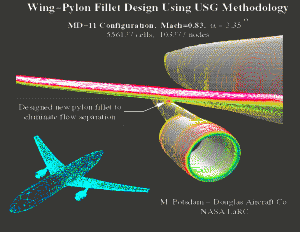In April 1992, NASA was approached by Douglas Aircraft Company (DAC) to use its emerging unstructured-grid software (later called TetrUSS), coupled with a design technique, to develop an advanced pylon for the MD-11 aircraft. A pylon outboard flow separation had been identified through flight test as a primary contributor to an unacceptable range shortfall for the aircraft thereby preventing FAA certification of the aircraft for long-range trans-pacific flights. A “tiger team” was formed to solve the problem within a three-month time constraint imposed by an impending flight test. A DAC engineer spent 6-weeks at Langley working with the team. The pylon design was successfully completed and flight-tested on the MD-11. The work is reported in AIAA Paper 93-3500.
DAC subsequently altered the pylon design for future aircraft, and distributed flight hardware for a retrofit fairing to be applied to the existing fleet. In addition to receiving FAA certification to long-range overwater routes, the projected fuel savings from the drag reduction was estimated to $50,000/aircraft/year which translates to an approximate savings of $8 Million/year for the airlines.


